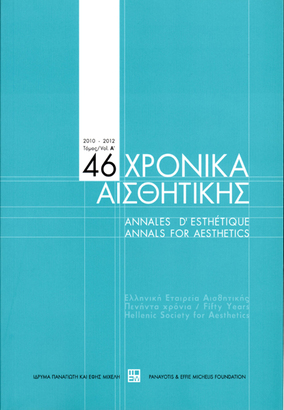Πίστη και παραφροσύνη : μια φιλοσοφική ερμηνεία του φωτός στο έργο του Rembrandt του 1635, Ο άγγελος σταματά τον Αβραάμ την ώρα που ετοιμάζεται να θυσιάσει τον Ισαάκ στον Θεό
Part of : Χρονικά αισθητικής : ετήσιον δελτίον της Ελληνικής Εταιρείας Αισθητικής ; Vol.45, 2009, pages 273-290
Issue:
Pages:
273-290
Parallel Title:
Faith and madness : a philosophical consideration of light in Rembrandt’s 1635 painting The angel stopping Abraham from sacrificing Isaac to God
Author:
Abstract:
Critics of Rembrandt’s 1635 painting The Angel Stopping Abraham from Sacrificing Isaac to God (oil on canvas 193.5x132.8 cm, Hermitage, St Petersburg) pay tribute to his picture’s lighting that, in accordance with baroque currents of the time, is deemed to be arbitrary. Drawing inspiration from his master Pieter Lastman and Caravaggio, Rembrandt is said to orchestrate an illumination of pictorial space in the biblical scene that he depicts, that hardly matches any natural situations. Light is rather artificial and, as a consequence, becomes an agent of the story depicted in painting. Moreover, light turns into a device that boosts into a climax the picture’s intensity by thematizing the viewer’s position close to action, and therefore by implicating the viewer’s participation in it. In this paper I shall attempt a philosophical consideration of the specific use of light in Rembrandt’s 1635 painting, arguing that by using the light arbitrarily, the painter wishes to draw attention to the paradox of faith that makes Abraham defy all ethics and rational rules of contact, and wish to sacrifice his only son, Isaac, to God. Choosing to be faithful to God and unfaithful to his son, Abraham discloses the necessary paradoxical condition that underlies faith: being faithful and responsible to one, I end up betraying others. Abraham himself is drawn close to madness when realizing this condition, i.e. that his decision to comply God’s will may eventually result in his son’s death, and believes until the very end that something may eventually happen and Isaac’s life will be spared. Rembrandt depicts Abraham, the faithful man and the tormented father at the instance of his decision, when he has finally lost all hope that a miracle may happen, and decides, pale, agitated, with tears on his eyes to perform his duty. Therefore Rembrandt’s light does have a philosophical task to illustrate madness as the instance of decision, with due consideration to the paradoxes of faith and responsibility.
Subject:
Subject (LC):
Keywords:
ζωγραφική
Notes:
Η διάλεξη πραγματοποιήθηκε στις 22 Φεβρουάριου 2010., Περιέχει εικόνες




